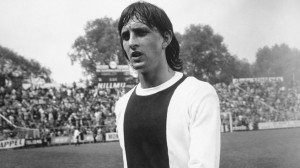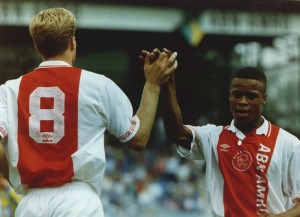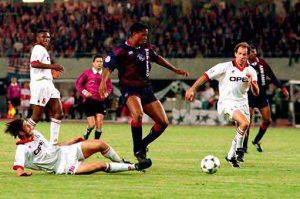The world famous Ajax Academy System, De Toekomst, has recently been reviewed by UEFA and has been voted the number one academy ahead of Barcelona, Borussia Dortmund, Real Madrid and Liverpool. De Toekomst, which translates to ‘The Future’, has produced some of the finest talents in world football down the years. It have produced some of the biggest names in Dutch football such as Johan Cruyff, Patrick Kluivert, Marco van Basten, Edgar Davids and Dennis Bergkamp but what makes the youth academy so good and produce so much home grown talent that goes on to great success?
Originally founded on 18th March 1900, De Toekomst’s facilities and are situated down the road from the Amsterdam Arena. There are around 14 hectares of various grass and artificial grass pitches, a stadium for reserve and youth games and a full sized, covered artificial grass pitch. The indoor dome, which was built in 2011, is another addition to De Toekomst and has a pitch and a variety of instruments designed to take the Ajax method to the cutting-edge of scientific development. There is a two-storey building which has locker rooms, class rooms, workout facilities and offices for coaches and sport scientists. Within the workout facilities, there is a weights room, a gym and a swimming pool for recuperation and a café where players are served meals. Visitors are also allowed to visit De Toekomst at free will to watch training sessions and games and can also visit the café where they can enjoy a glass of beer or a cappuccino while overlooking the training grounds. The only off-limits areas are the indoor pitch and the first team training area.
The main goal for Ajax is to have three players make it to the first team from the academy every two seasons, if they don’t achieve this it is seen as a failure. To achieve their aim, they have to get the right type of player in from the start and they do this through their extensive scouting network. Ajax’s preferred zone of recruitment is 50km around Amsterdam but they sometimes stretch their recruitment area across the Netherlands with fifty scouts and occasionally across Europe where five scouts are positioned. An example of this occurring is the signing of Christian Eriksen from Odense BK in 2008. At the time Eriksen, who was 16, joined Ajax’s youth academy after trials with Barcelona, Chelsea and Real Madrid. After his move to Ajax, Eriksen said, “My first step should not be too big. I knew that playing in the Netherlands would be very good for my development. Then Ajax arrived and that was a fantastic option.”
Eriksen signing for Ajax as a 16 year old
After finding the latest talent for the academy, the players have to go through a test stage called ‘talentdagen’, a stage where the coaches find out if they are good enough to be signed on a youth contract. In this stage the coaches look for a certain set of skills which would allow them to fit into the Ajax style of play. The desired skills for the young players include ball control, position play, movement habits, mind-set and T.I.P.S (Technique, Intelligence, Rapidity and Personality). If they pass this test stage, they are deemed to have the technical ability to progress into the academy.
The academy has over 200 players and has a variety of age groups which range from 5 year olds up to the Under 19s and Ajax 2, the reserve team. All these players are supervised by 13 coaches and the ideal coach for Ajax is an ex-player who had lots of experience at high levels of the game. An example of this is back in 2008 when former Ajax player Dennis Bergkamp was appointed as the U12 coach before moving onto the U19s in 2010 and now he is the assistant manager of the senior side. All the coaches at De Toekomst have a massive influence on each player’s development and are trusted in keeping with the Ajax philosophy at all times in preparation for the first team, if they make it that far.
 Rinus Michels: The man behind the Total Football tactic
Rinus Michels: The man behind the Total Football tactic
The system that Ajax use throughout the club is 4-3-3 system named Total Football, which was first created by Rinus Michels in the 1970s. During that era, Ajax played some of the finest football ever and had a 100% home record over two seasons and won the European Cup three times in a row. They also celebrated five title wins in 1972 (Eredivisie, KNVB Cup, European Cup, European Super Cup and the Intercontinental Cup). It was also further used by the Netherlands national football team at the 1974 World Cup where they achieved a second place finish.
The tactic’s success depends largely on the adaptability of each individual in the team and the ability to quickly switch positions depending on the on-field situation. It also requires the players to be comfortable in numerous positions and relies on the technical ability of the players, reinforcing the idea of training the academy players using this formation from an early age.
As previously mentioned, when they players come into the academy they are immediately exposed to the Total Football tactic. A report by the ECA on youth academies in Europe showed that children as young as eight are exposed to the 4-3-3 system. Under 8’s training sessions are mainly focused on passing, movement and finesse but confidence on the ball is the priority.
One of the great things are De Toekomst which English academies could learn from is that they believe that the children shouldn’t be over trained, the players evaluations only start at the age of 13. They believe that it is very beneficial for young players to not be over trained and 12 year old boys only train three times a week and then play a match on weekends.
“The coaches believe that children have their own lives and families and they should not be taken away from their daily lives, families and social environment for too long. When they are not training, young academy prospects should play on the street with their friends; this can be crucial to a player’s development both as a person and a football player.”
At this age the number of focuses in training increases up to seven which includes team spirit building. The other focuses at this age level include passing, technical training, positional play and finishing on goal.
Once the players reach the age of 15, the training level is upped and they train five times a week. Their training consists of short games and running exercises or sometimes in may be passing the ball over a short distance. The main focus for this age level is positional game play and games with many variations, as well as player evaluation.
Once the players at De Toekomst reach the age of 16 and 17, they are deemed to have ‘made it’ and are almost guaranteed a first team place in the near future, something that is extremely rare in the modern game. From this age during training, they are required to do 30m sprints with sensors to register times over five metres. The De Toekomst staff believes this is the distance over which acceleration occurs most often in real games.
De Toekomst has had many famous graduates over the years, perhaps too many to go into detail. I’ll go into detail of my four favourite graduates but there is plenty more graduates that could be talked about. Marco Van Basten, Marc Overmars, Frank and Ronald de Boer, Clarence Seedorf, Frank Rijkaard and Wesley Sneijder are just some of the names that have been produced by the famous academy.
Johan Cruyff
Probably the most famous player to come through De Toekomst, Cruyff became synonymous with the playing style of Total Football. He joined De Toekomst on his 10th birthday and made his first team debut, aged 17, against GVAV in 1964. Cruyff won a total of 20 honours during his time with Ajax which included eight Eredivisie titles, three back to back titles between 1965 and 1968. He also won the KNVB Cup five times and was part of the Ajax side that won three consecutive European Cups in the 1970s. Cruyff had numerous individual honours to go along with the team efforts for Ajax, he won the Ballon d’Or three times (1971, 1973, 1974), the European Golden Shoe (1968) and Dutch Footballer of the Year five times (1967, 1969, 1971, 1972, 1984). He ended his nine year affiliation with Ajax in 1973 when he moved to Barcelona and also played for Los Angeles Aztecs, Washington Diplomats, Levante, Feyenoord. Cruyff also returned for a two year spell with Ajax in 1981. He had massive success with the national side as well having made 48 appearances and scoring 33 goals. When Cruyff scored in a match for Netherlands, they never went onto lost the game. Cruyff led them to a runners-up medal in the 1974 World Cup and received the World Cup Golden Ball award for his efforts during the tournament.
Edgar Davids
Edgar Davids is perhaps the most recognisable footballer of all time due to his appearance of dreadlocks and protective goggles, which he wore due to glaucoma. He began his career at De Toekomst as a 12 year old and spent five years in the academy before making his debut in 1991 in a home win against RKC Waalwijk. During his five year original spell with the club, he helped Ajax win three Eredivisie titles and achieved success in Europe with a 1992 UEFA Cup win and the 1995 UEFA Champions League. In 1996, Ajax got to the final of the Champions League again but lost on penalties and Davids missed the first penalty in the shootout. He left Ajax in the summer of 1996 for the bright lights of Milan but only lasted a year before being transferred to Juventus. During his career he also enjoyed a loan spell to Barcelona and deals at Inter, Spurs, another spell at Ajax, Crystal Palace before ending up at current club Barnet in 2012 – where he now manages. He was capped 74 times by the Netherlands, during which he represented his country once at the World Cup and three times at the European Championships, and scored six goals.
Bergkamp and Davids: Two of the greatest players to come through De Toekomst
Dennis Bergkamp
Bergkamp was born in Amsterdam in 1969 and joined the famous academy in 1981 as an 11 year old. He was brought through the system and handed his debut against Roda JC in 1986 by Johan Cruyff. Bergkamp scored his first goal for the club in 1987 against HFC Haarlem before establishing himself as a first team player in the late 80s. In the 1990-91 season, he was the Eredivisie’s joint top goalscorer with Romario after he scoring 29 goals in 36 games. During his time with Ajax, he made 239 appearances, scoring 122 goals and he was voted Dutch Footballer of the Year in 1992 and 1993. He moved to Inter Milan in February 1993 for £7.1m before moving onto the club where he achieved most success, Arsenal. His international career saw him make 79 appearances with 37 goals, a record which was taken over by the next graduate I will be talking about, Patrick Kluivert. During his career, he achieved 22 individual honours which included Dutch Football Talent of the Year (1990), Ballon d’Or (1992, 1993) and PFA Team of the Year (1997-98).
Patrick Kluivert
Kluivert joined De Toekomst at the age of seven after learning to play football on the streets. During his time at the academy he played in a variety of positions including defender but he was too strong in technique, football intelligence and speed and was made a striker. He made his Ajax debut as an 18 year old in the Dutch Super Cup victory against Feyenoord and opened the scoring in the game. He was part of Ajax’s Golden Generation in the early 1990s which featured the likes of Edwin van der Sar, Marc Overmars and Clarence Seedorf. Kluivert came off the bench in the 1995 Champions League final to score an 85th minute winner against one of his future clubs, AC Milan. During his career he also played for Barcelona, Newcastle, Valencia, PSV and Lille. He also had huge success with the national side making 79 appearances and is the all-time leading Netherlands goalscorer with 40 goals.
However all these graduates are in the past now and Ajax have suffered in recent times due to other top domestic leagues going global. Other domestic leagues have lucrative TV revenues coming in yearly whereas the Eredvisie has little income compared to them forcing Ajax to become a player factory and selling their star talents when they reach a certain market value. Over recent years they have been forced to sell players but Ajax have made huge profits from them. Examples of this include Thomas Vermaelen (£12m), John Heitinga (£12m), Wesley Sniejder (£27m), Rafael van der Vaart (£5.5m) and Gregory van der Wiel (£6m).
From the profits they make, Ajax re-invest most of the money in young stars of the future and, as previously mentioned, they sometimes look abroad for the best young players to bring to De Toekomst to transform into stars and sell on for profit. Two of the best examples of recent times are Danish midfielders Christian Eriksen and Viktor Fischer.
Viktor Fischer: One of the brightest talents at Ajax
Eriksen signed for Ajax from Odense BK in 2008. At the time Eriksen, who was 16, joined Ajax’s youth academy after trials with Barcelona, Chelsea and Real Madrid. He worked his way through the the youth teams and was promoted to the first team in January 2010 before making his debut within a month against NAC Breda. Eriksen was compared to the Ajax youth products Wesley Sneijder and Rafael van der Vaart by Martin Jol. He also said that he was a good reader of the game in the number 10 role, a role which he commonly features in for both club and country. Eriksen’s breakthrough season came in 2010-11, during which he was named as Danish Talent of the Year, Ajax’s Talent of the Year and Dutch Football Talent of the Year. Since then he has had a rising influence in the squad and has recently been linked with big money moves to Liverpool and Borussia Dortmund.
Viktor Fischer impressed visiting Ajax scouts in the U17 World Cup in Mexico and signed for them after trials with Manchester City, Chelsea and Inter Milan. Similar to Eriksen, Fischer joined Ajax for the chances to develop as a player in the famed De Toekomst academy. During his time with Denmark U17’s, he scored 20 goals in 30 appearances – an impressive feat. Fischer made his first team debut in a friendly at the start of last season against SV Huizen and then made his Eredivisie debut in October 2012. In his debut season, he emerged as Frank de Boer’s first choice left winger and scored in the game that secured Ajax’s 32nd Eredivisie title. He was also named Ajax’s Talent of the Year for his outstanding debut season which saw him score ten goals in the league, twelve in all competitions. Fischer made his senior international debut in November 2012 and has so far made 2 appearances for Denmark and looks set to have a very good future in the game.
Stefano Denswil is one of the young Dutch players to come into the first team this season
As well as having non-Dutch players coming through the ranks and impressing the coaches, Ajax also have a number of Dutch players that have a big future at the Amsterdam Arena. One of these is Stefano Denswil, who played a big part for Ajax in the 2011-12 NextGen Series as they reached the final before being beaten on penalties. Denswil was announced as a member of the first team squad at the start of last season after impressing for Jong Ajax. He only made three appearances for the first team but had a scoring debut in the KNVB Cup against ONS Sneek as he scored a free kick in the 88th minute.
Let’s just hope that all these players, that have the potential to do big things, will live up to their expectations and perform at the highest level. Without De Toekomst and the development of their youngsters, we may not have seen some of the greatest footballing talents to ever grace the footballing world. Hopefully one day Ajax will be able to compete with the biggest team’s in football and keep hold of their high quality players instead of being a player factory and selling them on for profit.








Nice article, but the fact of the matter is that nowdays money is the deciding factor for young kids. A lot off kids turn down the oppertunity to play for Ajax and rather take the money and play for a Premier League side. So these rich clubs are fishing away potential Ajax targets with money and eventually nothing becomes of those players. The only way that i see Ajax prosper again is if the FIFA made rules about how many players a football club can have under contract. Because if you look at chelsea they have started hording players that they just loan out because they don’t have a place for them thats ruins football. But with the changes at De Toekomst i also think more talent will be avaible for Ajax in the future. Ajax will never achieve the level of Madrid, Barca, Dortmund or Bayern. But if Ajax can achieve the level of Porto,Benfica, A.Madrid, Valencia etc.. That would be more then ok for me as an Ajax supporter.
Good article, I read it in Late Tackle. Just one thing though, I’m taking my level 1 coaching at the moment and have been told TIPS stands for technique, intelligence, personality and speed not as stated in the article?